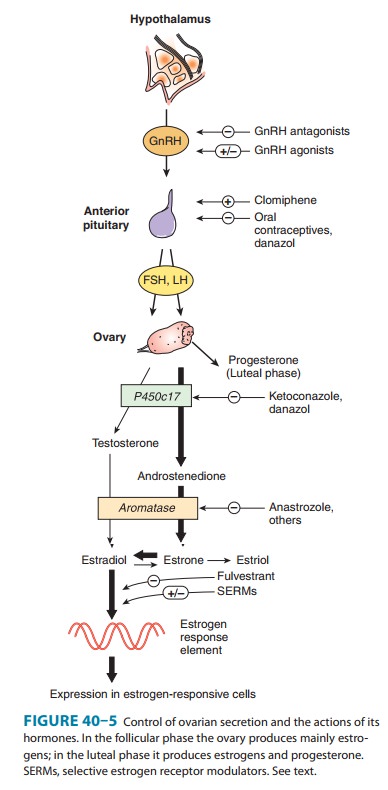Chapter: Basic & Clinical Pharmacology : The Gonadal Hormones & Inhibitors
Danazol
DANAZOL
Danazol, an isoxazole
derivative of ethisterone (17α-ethinyltestosterone) with weak
progestational, androgenic, and glucocorticoid activities, is used to suppress
ovarian function. Danazol inhibits the midcycle surge of LH and FSH and can
prevent the compensatory increase in LH and FSH following castration in
animals, but it does not significantly lower or sup-press basal LH or FSH
levels in normal women (Figure 40–5). Danazol binds to androgen, progesterone,
and glucocorticoid recep-tors and can translocate the androgen receptor into
the nucleus to initiate androgen-specific RNA synthesis. It does not bind to
intracellular estrogen receptors, but it does bind to sex hormone-binding and
corticosteroid-binding globulins. It inhibits P450scc (the cholesterol side
chain-cleaving enzyme), 3β-hydroxysteroid dehydrogenase, 17α-hydroxysteroid
dehydrogenase, P450c17 (17α-hydroxylase), P450c11 (11β-hydroxylase), and
P450c21 (21β-hydroxylase).
However, it does not inhibit aromatase, the enzyme required for estrogen
synthesis. It increases the mean clearance of progesterone, probably by
competing with the hormone for binding proteins, and may have similar effects
on other active steroid hormones. Ethisterone, a major metabolite of danazol,
has both progestational and mild androgenic effects.

Danazol is slowly
metabolized in humans, having a half-life of over 15 hours. This results in
stable circulating levels when the drug is administered twice daily. It is
highly concentrated in the liver, adrenals, and kidneys and is excreted in both
feces and urine.
Danazol has been
employed as an inhibitor of gonadal func-tion and has found its major use in
the treatment of endometrio-sis. For this purpose, it can be given in a dosage
of 600 mg/d. The dosage is reduced to 400 mg/d after 1 month and to 200 mg/d in
2 months. About 85% of patients show marked improvement in 3–12 months.
Danazol has also been
used in the treatment of fibrocystic dis-ease of the breast and hematologic or
allergic disorders, including hemophilia, Christmas disease, idiopathic
thrombocytopenic purpura, and angioneurotic edema.
The
major adverse effects are weight gain, edema, decreased breast size, acne and
oily skin, increased hair growth, deepening of the voice, headache, hot
flushes, changes in libido, and muscle cramps. Although mild adverse effects
are very common, it is seldom necessary to discontinue the drug because of
them. Occasionally, because of its inherent glucocorticoid activity, dana-zol
may cause adrenal suppression.
Danazol should be used
with great caution in patients with hepatic dysfunction, since it has been
reported to produce mild to moderate hepatocellular damage in some patients, as
evidenced by enzyme changes. It is also contraindicated during pregnancy and
breast-feeding, as it may produce urogenital abnormalities in the offspring.
Related Topics